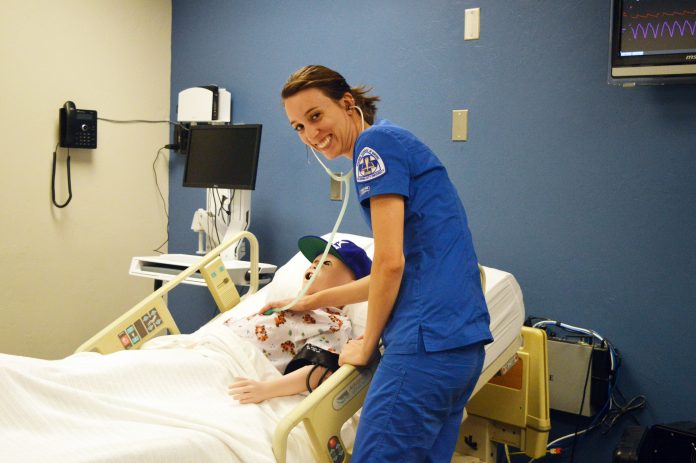
story and photo by Traci Chapman, Staff Writer
Before clinicals, it’s often difficult for nursing students to have true hands-on experience, to take that extra step beyond the academic world to the real world – but for the 500 students at Oklahoma City University’s Kramer School of Nursing, that’s no longer the case.
“We wanted to give our students every opportunity to have this kind of experience early on and to be able to interact with ‘patients’ in a meaningful way in a type of classroom environment,” said Christopher Black, nursing school communications and outreach director. “This is a way for them to have that patient interaction, with the opportunity to get the feedback from their instructors they need to move forward.”
That patient interaction comes thanks to OKCU’s newly opened Meinders Nursing Simulation Center, a facility featuring seven simulated hospital rooms and including responsive manikins, who can speak with and will fully interact with students, as they deal with real-life nursing challenges. “Patients” will have medical histories and will respond to the treatment they receive, not only verbally, but also through their vital signs – anatomically correct manikins will feature pulses and respiration, things that are communicated through the types of monitoring equipment students will utilize once they begin working in medical facilities during their clinicals and beyond, officials said.
Rooms run from general hospital scenarios to more specific treatment facilities – like labor and delivery and intensive care, Black said. Instructors provide patients’ voices and program medical issues for students to resolve, as they remain in one of four observation rooms, located between two simulated “treatment” areas.
“It can be just about anything – a patient could have a heart attack, a reaction to medication, something small or large,” Black said. “This kind of simulation is invaluable – we’ve found several research studies that back how important this is and how it can help a student in learning to deal with high-risk situations.”
The new wing also features rooms where students can meet with their professors for critical analysis after a simulation session, as well as bounce ideas off each other for dealing with a particular situation, Black said. Those areas – two debriefing/conference rooms – are just one part of renovations that also include a computer laboratory and two instructor offices.
Another unique feature of the Meinders Center is a home simulation area, Black said. Featuring a basic bedroom scenario with attached bathroom, the space allows students who want to go into or are interested in home health nursing to understand the constraints of that kind of care – and learn about the challenges facing those they will be treating.
The Meinders’ renovations extend outside the clinical arena, however. Black said administrators also wanted to give students a space where they could relax, socialize and reflect. That led to the configuration of a student relaxion patio located adjacent to the Meinders Center, as well as a prayer labyrinth that can offer students a chance to meditate and get some space from the pressures of school, studies and life in general, he said.
While OKCU’s Kramer School of Nursing has been leading students into the world of nursing for more than 30 years, the opening of the Meinders Center is a giant step forward for the school’s 30-plus full-time nursing faculty members and roughly 500 students, Black said. The 16,000-square-foot area until 2010 housed the entire nursing school, meaning faculty and staff were crammed in with the roughly 300 students attending at that time.
OKCU’s nursing evolution began in 2010, when the school unveiled an $8.5 million expansion. That added 50,000 square feet, 10 classrooms, three labs and six seminar rooms – quadrupling the size of the nursing school and paving the way for an exploding student population.
Kramer offers Bachelor of Science in Nursing and RN-to-BS programs, as well as Master of Science in Nursing, Doctor of Nursing Practice and Nursing PhDs.
Like teaching, Oklahoma faces another critical shortage – nurses. OKCU’s nursing school’s technological teaching leaps come at a critical time, as the state hovers toward the bottom of the country in number of nurses, according to data from the Oklahoma Board of Nursing and state Bureau of Labor Statistics. That’s why simulation facilities like the Meinders Center are so important in encouraging more people to enroll in nursing school and providing those students the most comprehensive education possible, officials said.
“The types of tools we have here mean we can best prepare our students for what they’ll face in the real world and the types of situations they might encounter,” Black said. “Opening this simulation center is a huge step in making sure they are ready to do that.”
More information about the Kramer School of Nursing and Meinders Simulation Center are available online at https://www.okcu.edu/nursing/home.











